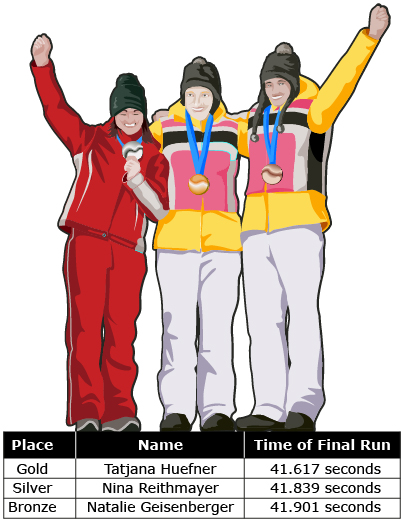Module 3 Project
1. Module 3 Project
1.2. Page 3
Module 3: Slope and Rate of Change
Step 3
To ensure the safety of lugers, the International Luge Association has set specific guidelines for track design and construction. There are a few requirements, but you will focus on the ones specifically regarding slope.
Track Regulation from the International Luge Federation |
The track gradient should be designed in such a way that a speed of about 80 km/h is reached approximately 250 m after the start. The average gradient of a track from the men’s start to the low point should not exceed 10%. The average gradient of the second half of the track should not exceed 8%. The calculated maximum speed must not exceed 135 km/h.
The gradient of the outrun must not exceed 20% and must give athletes the possibility for an exit along one side. |
- Use the slope calculations and other information from Step 2 to calculate the gradients for each section of the two tracks. (12 marks)
Track
Gradient of Top
Half of Course
Gradient of Bottom
Half of Course
Canada Olympic Park
Whistler Sliding Centre
- Examine the chart and discuss how safe each track is in terms of slope. Does each track meet the International Luge Association standard regulations? (2 marks)
Step 4
Luge at the Vancouver Olympics in 2010 had several different competitions. There were individual and doubles competitions. Individuals made four runs down the track with the lowest total time winning. Doubles made two runs down the track and, again, the lowest total time won.
- Use the women’s luge course length (3914 ft) and the information in the table to answer the questions that follow.

- Find the fastest time in the final round for women medal winners and determine the speed in feet per second. Round your answer to the nearest thousandth of a foot per second. (3 marks)
- Find the slowest time in the final round for women medal winners and determine the speed in feet per minute. Round your answer to the nearest foot per minute. (3 marks)
- Find the fastest time in the final round for women medal winners and determine the speed in feet per second. Round your answer to the nearest thousandth of a foot per second. (3 marks)
- Use the men’s doubles luge course length (3914 ft) and the information in the table to answer the questions that follow.

- i. Find the average time for one run for the Lingers.
ii. Calculate their average speed in feet per second. Round your answer to the nearest thousandth of a foot per second. (4 marks)
- i. Find the average time for one run for the silver-medal-winning Sics.
ii. Calculate their average speed in feet per minute. Round your answer to the nearest foot per minute. (4 marks)
- i. Find the average time for one run for the Lingers.
- How do the fastest single and double times compare? What reasons can you suggest for this difference in speed? (4 marks)